Microstructure and Phase Transformation Analysis of Ni50−xTi50Lax Shape Memory Alloys
Abstract
:1. Introduction
2. Materials and Methods
3. Results
4. Discussion
4.1. Microstructure Formation Analysis
4.2. Phase Transformation Behavior
5. Conclusions
Author Contributions
Funding
Acknowledgments
Conflicts of Interest
References
- Philip, T.V.; Beck, P.A. CsCl-Type ordered structures in binary alloys of transition elements. JOM 1957, 9, 1269–1271. [Google Scholar] [CrossRef]
- Kudoh, Y.; Tokonami, M.; Miyazaki, S.; Otsuka, K. Crystal-structure of the martensite in Ti-49.2 at.%Ni alloy analyzed by singly-crystal X-ray-diffraction method. Acta Metall. 1985, 33, 2049–2056. [Google Scholar] [CrossRef]
- Jani, J.M.; Leary, M.; Subic, A.; Gibson, M.A. A review of shape memory alloy research, applications and opportunities. Mater. Des. 2014, 56, 1078–1113. [Google Scholar] [CrossRef]
- Otsvka, K.; Ren, X. Physical metallurgy of Ti-Ni-based shape memory alloys. Prog. Mater. Sci. 2005, 50, 511–678. [Google Scholar] [CrossRef]
- Ma, J.; Karaman, I.; Noebe, R.D. High temperature shape memory alloys. Metall. Rev. 2010, 55, 257–315. [Google Scholar] [CrossRef]
- Wu, S.K.; Wayman, C.M. Martensitic transformation and the shape memory effect in Ti50Ni10Au40 and Ti50Au50 alloys. Metallography 1987, 20, 359–376. [Google Scholar] [CrossRef]
- Lo, Y.C.; Wu, S.K. Compositional dependence of martensitic transformation sequence in Ti50Ni50−xPdx alloys with x ≦ 15 at.%. Scr. Metal. Mater. 1992, 26, 1875–1877. [Google Scholar] [CrossRef]
- Pushin, V.G.; Kuranova, N.N.; Pushin, A.V.; Uksusnikov, A.N.; Koirov, N.I. Structure and thermoelastic martensitic transformations in ternary Ni–Ti–Hf alloys. Tech. Phys. 2016, 61, 51–56. [Google Scholar] [CrossRef]
- Nespoli, A.; Villa, E.; Besseghini, S. Characterization of the martensitic transformation in Ni50−xTi50Cux alloys though pure thermal measurements. J. Alloy. Comp. 2011, 509, 644–647. [Google Scholar] [CrossRef]
- Cai, W.; Liu, A.L.; Sui, J.H.; Zhao, L.C. Effects of cerium addition on martensitic transformation and microstructure of Ti49.3Ni50.7 alloy. Mater. Trans. 2006, 47, 716–719. [Google Scholar] [CrossRef]
- Liu, A.L.; Cai, W.; Gao, Z.Y.; Zhao, L.C. The microstructure and martensitic transformation of (Ti49.3Ni50.7)1−xGdx shape memory alloys. Mater. Sci. Eng. A 2006, 438–440, 634–638. [Google Scholar] [CrossRef]
- Liu, A.L.; Gao, Z.Y.; Cao, L.; Cai, W.; Wu, Y. Effect of Dy addition the microstructure and martensitic transformation of a Ni-rich TiNi shape memory alloy. Alloy Comp. 2007, 437, 339–343. [Google Scholar] [CrossRef]
- Liu, A.L.; Sui, J.H.; Lei, Y.C.; Cai, W.; Gao, Z.Y.; Zhao, L.C. Effect of Y addition on microstructure and martensitic transformation of a Ni-rich Ti–Ni shape memory alloy. J. Mater. Sci. 2007, 42, 5791–5794. [Google Scholar] [CrossRef]
- Zhao, C.W.; Li, W.Y.; Zhao, S.L.; Jin, Y.J.; Meng, X.K.; Hou, Q.Y. Effect of La addition on the microstructure and martensitic transformation of Ni–Ti–La alloys. Vacuum 2017, 137, 169–174. [Google Scholar] [CrossRef]
- Luo, H.B.; Shan, F.L.; Huo, Y.L.; Wang, Y.M. Effect of precipitates on phase transformation behavior of Ti-49 at.% Ni film. Thin Solid Films 1999, 339, 305–308. [Google Scholar] [CrossRef]
- Itin, V.I.; Bratchikov, A.D.; Merzhanov, A.G.; Doronin, V.N. Relation between combustion parameters and phase diagram for the systems Ti–Co and Ti–Ni. Combust. Explo. Shock. 1982, 18, 536–539. [Google Scholar] [CrossRef]
- Liu, J.Q.; Geng, K. The isothermal section of the phase diagram of the La–Ni–Ti ternary system at 673 K. J. Alloy Compd. 2000, 312, 121–123. [Google Scholar]
- Miedema, A.R.; Boer, F.R.D. Predicting heat effects in alloys. Phys. B 1981, 103, 67–81. [Google Scholar] [CrossRef]
- Mousavi, T.; Abbasi, M.H.; Karimzadeh, F. Thermodynamic analysis of NiTi by mechanical alloying. Mater. Lett. 2009, 63, 786–788. [Google Scholar] [CrossRef]
- Boer, F.R.D.; Boom, R.; Mattens, W.C.M.; Miedema, A.R.; Niessen, A.R. Fundamentals of the model. In Cohesion in Metals, 2nd ed.; Elsevier Inc.: Amsterdam, The Netherlands, 1988; pp. 24–25. [Google Scholar]
- Hu, R.X.; Nash, P.; Chen, Q. Enthalpy of formation in the Al–Ni–Ti System. J. Phase Equilib. Diffus. 2009, 30, 559–563. [Google Scholar] [CrossRef]
- Gachon, J.C.; Notin, M.; Hertz, J. The enthalpy of mixing of the intermediate phases in the systems FeTi, CoTi, and NiTi by direct reaction calorimetry. Thermochim. Acta 1981, 48, 155–164. [Google Scholar] [CrossRef]
- Yin, J.Y.; Li, G.F.; Si, Y.S.; Ying, G.; Peng, P. Micro mechanism of Cu and Fe alloying process on the martensitic phase transformation of NiTi-based alloys: First-principles calculation. J. Struct. Chem. 2015, 56, 1051–1057. [Google Scholar] [CrossRef]
- Liu, Y.N.; Blanc, M.; Tan, G.; Kim, J.I.; Miyazaki, S. Effect of ageing on the transformation behavior of Ti-49.5 at.% Ni. Mater. Sci. Eng. A 2006, 438–440, 617–621. [Google Scholar] [CrossRef]
- Tang, W. Thermodynamic study of the low-temperature phase B19’ and the martensitic transformation in near-equiatomic TiNi Shape Memory Alloys. Mater. Trans. A 1997, 28, 537–544. [Google Scholar] [CrossRef]
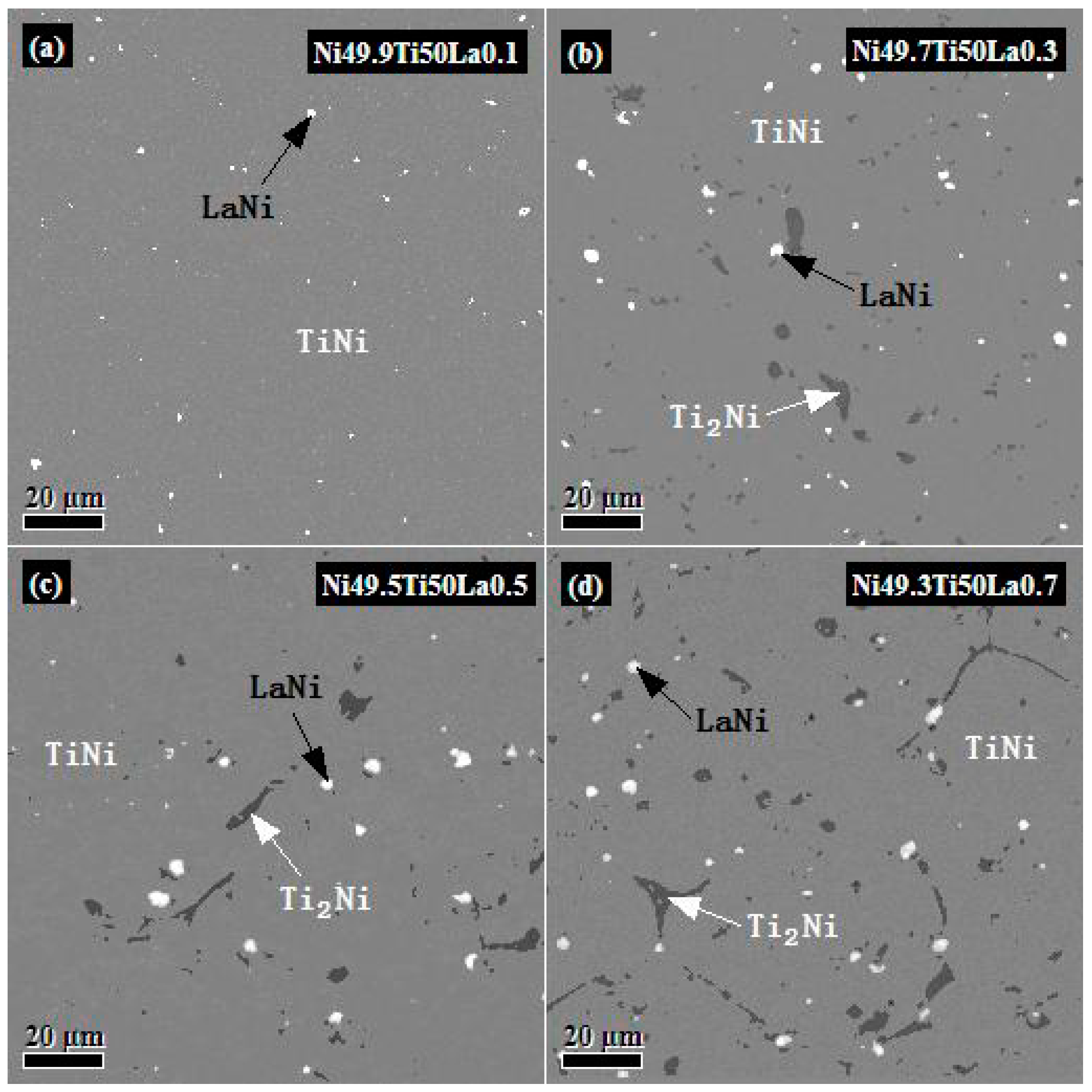
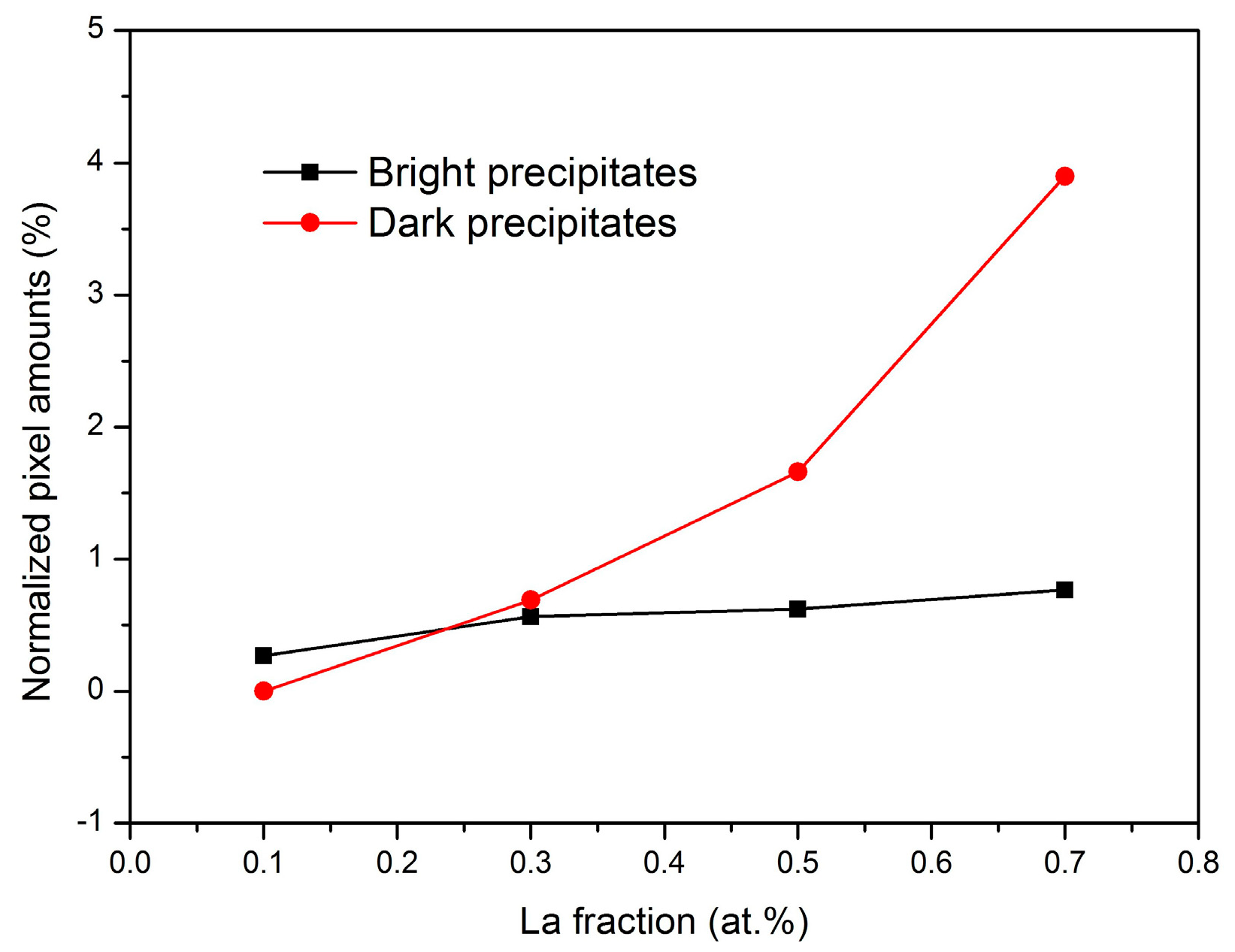

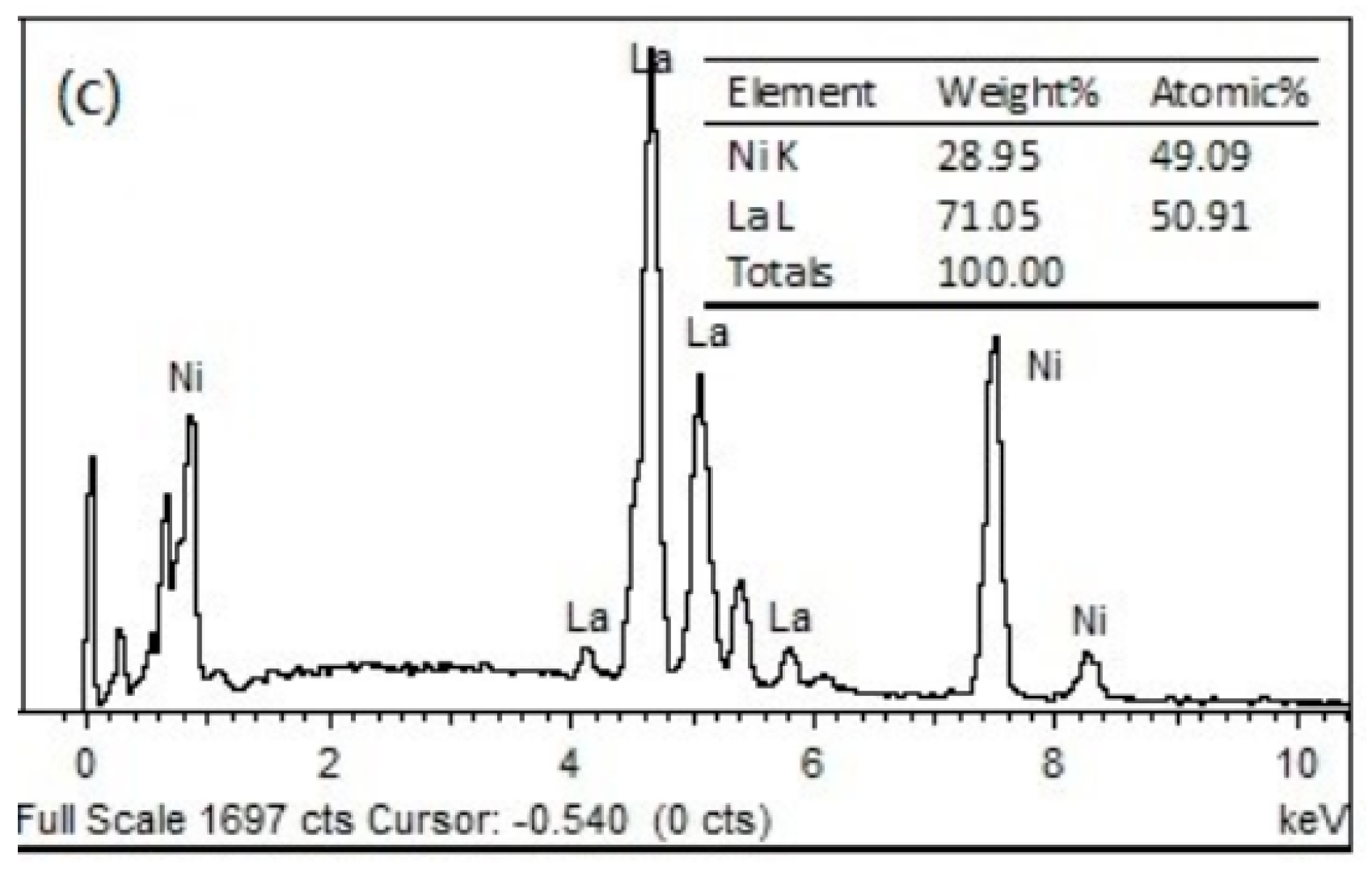
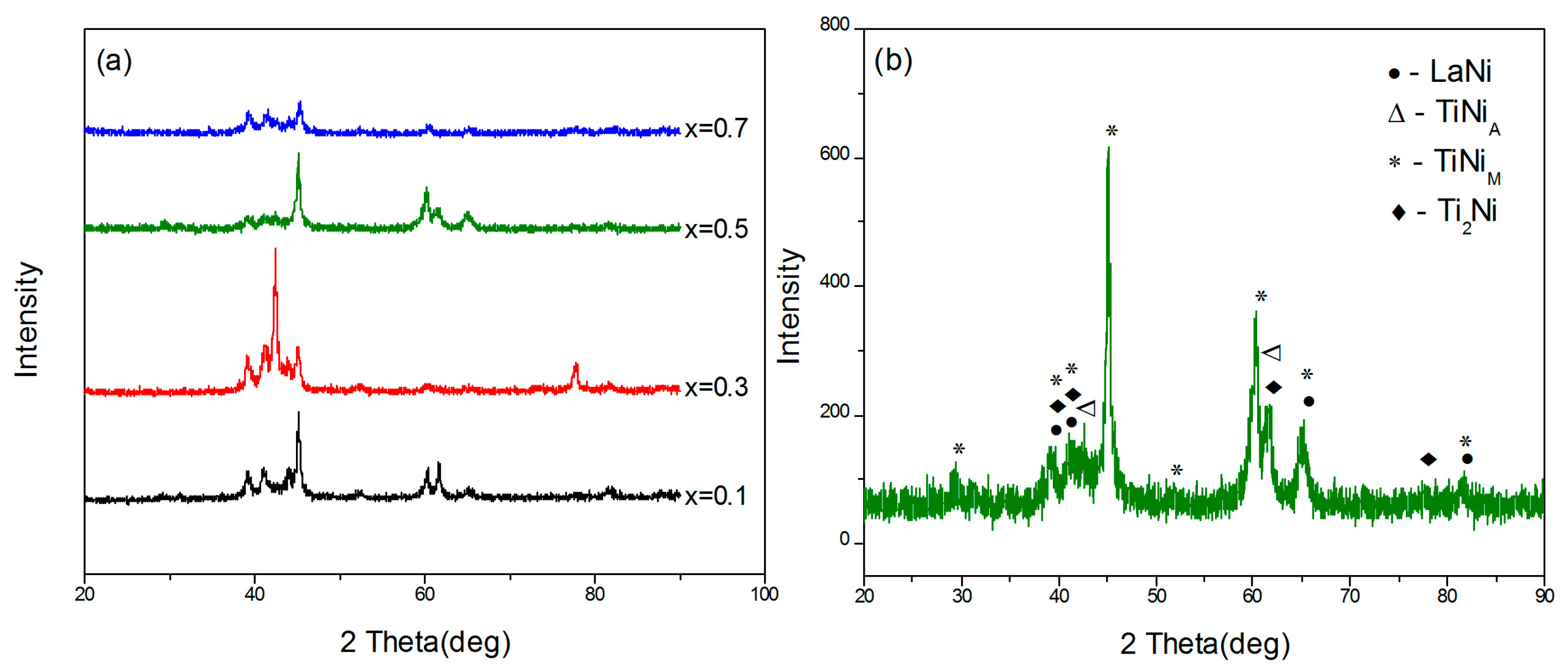
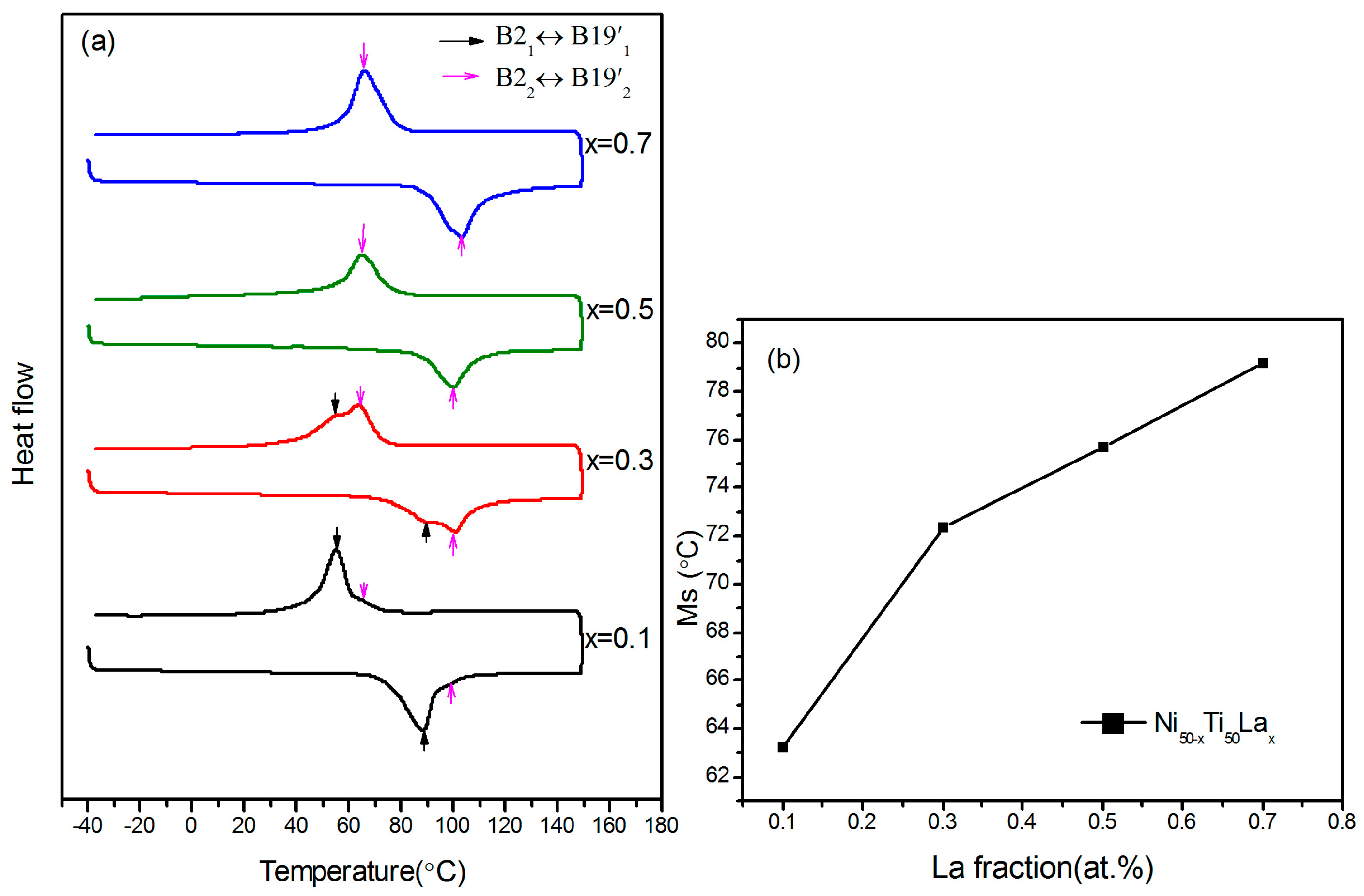
| Alloys | Phase | Ti (at.%) | Ni (at.%) | La (at.%) |
|---|---|---|---|---|
| Ni49.9Ti50La0.1 | matrix | 50.6 | 49.4 | |
| bright precipitates | 48.9 | 51.1 | ||
| Ni49.7Ti50La0.3 | matrix | 50.4 | 49.6 | |
| bright precipitates | 49.1 | 50.9 | ||
| dark precipitates | 66.7 | 33.3 | ||
| Ni49.5Ti50La0.5 | matrix | 51.0 | 49.0 | |
| bright precipitates | 50.3 | 49.7 | ||
| dark precipitates | 66.8 | 33.2 | ||
| Ni49.3Ti50La0.7 | matrix | 50.9 | 49.1 | |
| bright precipitates | 49.1 | 50.9 | ||
| dark precipitates | 66.7 | 33.3 |
| ϕ | |||
|---|---|---|---|
| Ni | 1.75 | 3.5 | 5.2 |
| Ti | 1.47 | 4.8 | 3.65 |
| La | 1.18 | 7.94 | 2.86 |
© 2018 by the authors. Licensee MDPI, Basel, Switzerland. This article is an open access article distributed under the terms and conditions of the Creative Commons Attribution (CC BY) license (http://creativecommons.org/licenses/by/4.0/).
Share and Cite
Li, W.; Zhao, C. Microstructure and Phase Transformation Analysis of Ni50−xTi50Lax Shape Memory Alloys. Crystals 2018, 8, 345. https://doi.org/10.3390/cryst8090345
Li W, Zhao C. Microstructure and Phase Transformation Analysis of Ni50−xTi50Lax Shape Memory Alloys. Crystals. 2018; 8(9):345. https://doi.org/10.3390/cryst8090345
Chicago/Turabian StyleLi, Weiya, and Chunwang Zhao. 2018. "Microstructure and Phase Transformation Analysis of Ni50−xTi50Lax Shape Memory Alloys" Crystals 8, no. 9: 345. https://doi.org/10.3390/cryst8090345





